|
Count
Dracula's War on Islam
A
True Story of Power, Cruelty and Betrayal
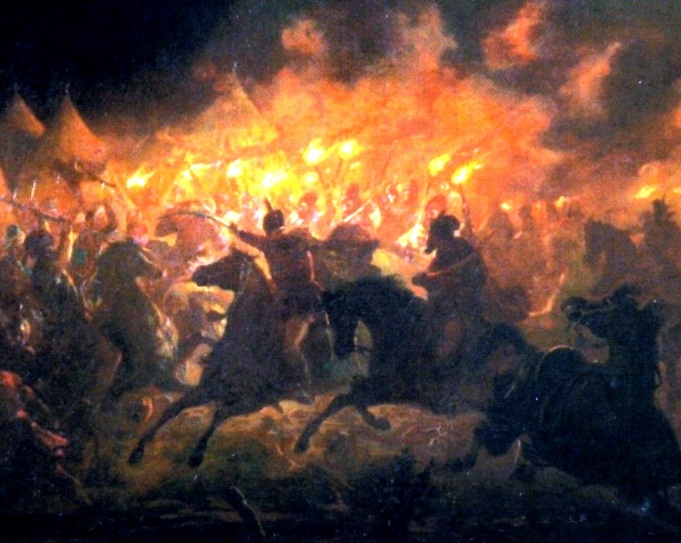
Dracula leading a charge against Islamic
troops in the Battle with Torches in Romania, 1492 (by Theodor Aman).
The Crusades
had failed. The holy lands were firmly in control of the Ottoman
(Turkish) Empire. Defeated, European knights vowed to one day return
and free Jerusalem from the Islamic Turks and the Order of the Dragon
was born. To be a knight of this Order, you had to proclaim a solemn
vow to continue to fight against the enemies of Christianity, in
particular the Ottoman Empire. But betrayal awaited this determined
group of knights.
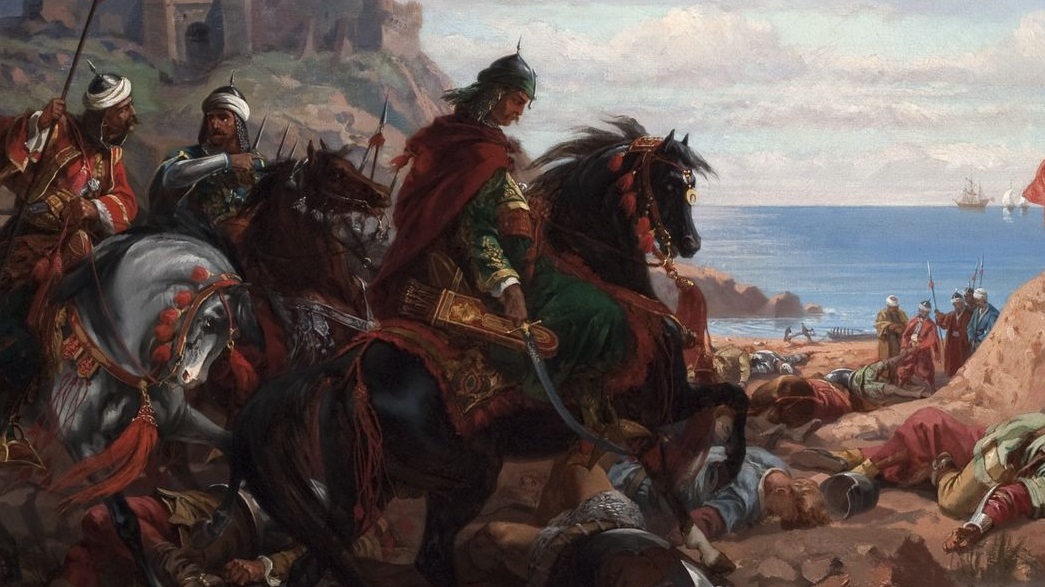
Ottoman Cavalry riding past dead Christian troops, 1444. (by Stanisław
Chlebowski)
Vlad II, a
Romanian war lord joined the Order of the Dragon and was re-named Vlad
Dracul, or Vlad the Dragon. The Holy Roman Emperor in turn recognized
Vlad as the rightful leader of the Romanian region of Wallachia which by
1436 was firmly under his control. But with the Ottoman Empire at his
doorstep, Vlad chose to betray his Order and the Holy Roman Empire by
assisting the Islamic forces in their invasion of neighbouring
Transylvania. In response, Vlad was stripped of his right to Wallachia.
But the ensuing melee provided the Ottoman sultan with an opportunity.
The Ottomans
conquered Wallachia, Vlad Dracul was reinstated as ruler and Wallachia
became a vassal to the Turks. In essence Vlad controlled a buffer zone
between the Ottomans and the Holy Roman Empire and he was beholden to
the Ottoman sultan to remain in power. To ensure Vlad’s shaky loyalty,
the sultan took as a hostage his teenaged son and heir, Vlad Dracula.
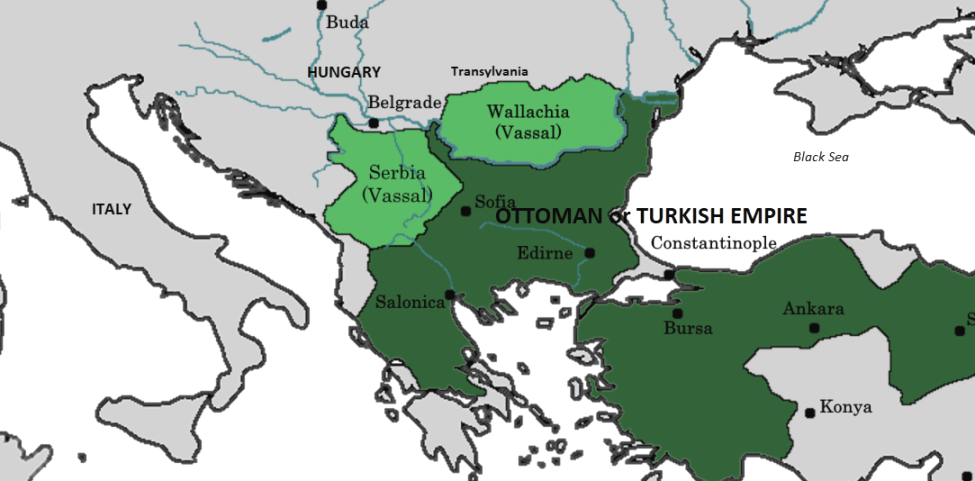
The Ottoman or Turkish Empire at the Time of Dracula (Wiki)
As the sultan’s
hostage Vlad Dracula witnessed first hand how the Ottoman leader kept
control of his empire. He ruled with ruthlessness and cruel
consequences to those who did not obey him. Young Dracula remained in
the gilded cage of the sultan’s court for five years. Despite Ottoman
efforts, Vlad Dracula never converted to Islam. But during his time with
the Ottomans, he witnessed the sultan abdicate to his young son, only to
return to power to defeat Christian forces in 1444. Insurrections
within the empire were crushed and rebels were publicly executed by slow
impalement.
At the age of 19,
Dracula learned that the Transylvanians had conquered Wallachia, killing
his father in the process. The Ottomans seemed to encourage Vlad’s
efforts to take back Wallachia, but their military support was
lacklustre. Without needed supplies and armed men from the sultan, Vlad
Dracula turned to the other major power in the region for help: Hungary.
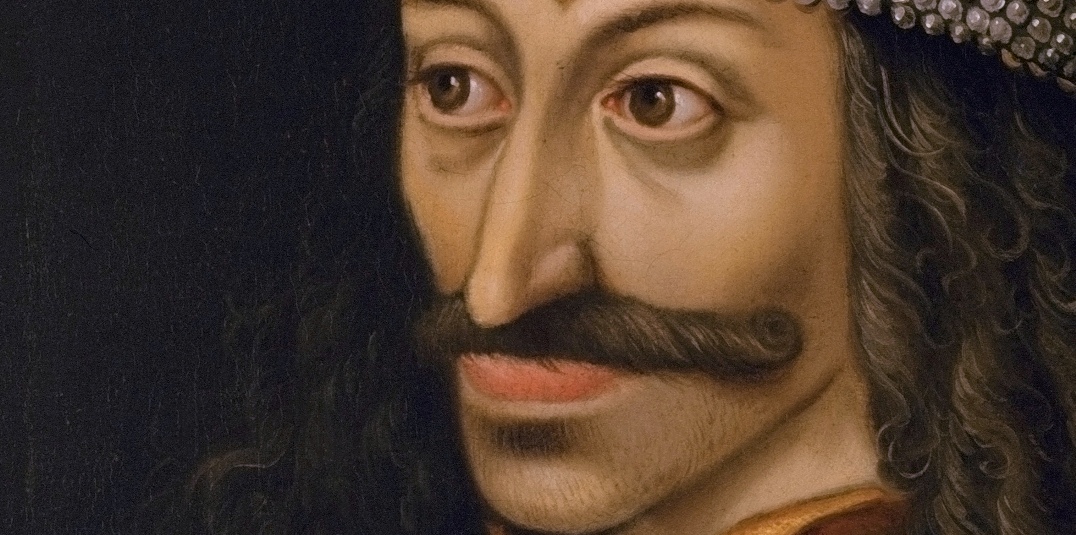
The true face of Dracula who murdered tens of thousands.
(Ambras Castle)
After six long years of preparation, Dracula
invaded Wallachia and overthrew Vladislav, the Transylvanian-backed
ruler and murderer of his father. In fact, Vlad Dracula took the
opportunity to personally kill his father’s murderer during hand-to-hand
combat. Dracula had come home.
Fresh with power,
Vlad Dracula proclaimed himself as ruler of Wallachia, the tenth one in
the past fifty years. Some chose to plot to depose him, with support
from neighbouring Transylvania. Dracula lashed out. Much like the
Ottoman strategy he observed during his teenage years, Dracula proceeded
to destroy any who opposed him. He immediately purged the ranks of the
Wallachian nobility.
Vlad then invaded
Transylvania, plundering bordering villages and impaling those he
captured on stakes. So frequent was his use of this slow and torturous
form of execution that he became known as Vlad the Impaler. The Germanic
Transylvanians spread rumours throughout Europe that Vlad Dracula also
drank the blood of his victims. Publications of Vlad’s notorious deeds
became popular social fodder in German-speaking regions, cementing
Dracula’s place in history.
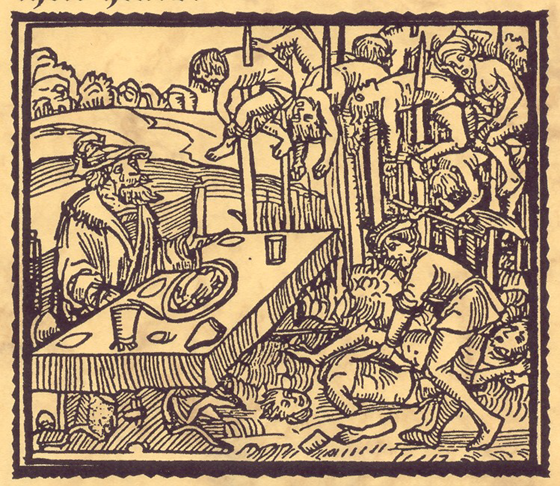
Original Wood Cutting of Vlad Dracula and his "forest" of
Transylvanian victims. Dracula was
accused of drinking human blood. War propaganda often made similar
claims of cannibalism against an enemy.
By 1462,
Dracula had vanquished all his opponents. His satisfaction was short lived
however as the Ottomans then demanded a jizya or tax be paid by all
non-Muslims. This was followed by the new sultan, Mehmed the Conqueror,
demanding that Vlad come pay homage to him personally. Yet when Vlad’s
father had done this many years before, it had ended with both of them
firmly under Turkish control: him as a hostage and his father a puppet.
Dracula’s fears were soon verified. He learned that the new sultan intended
to ambush and imprison him.
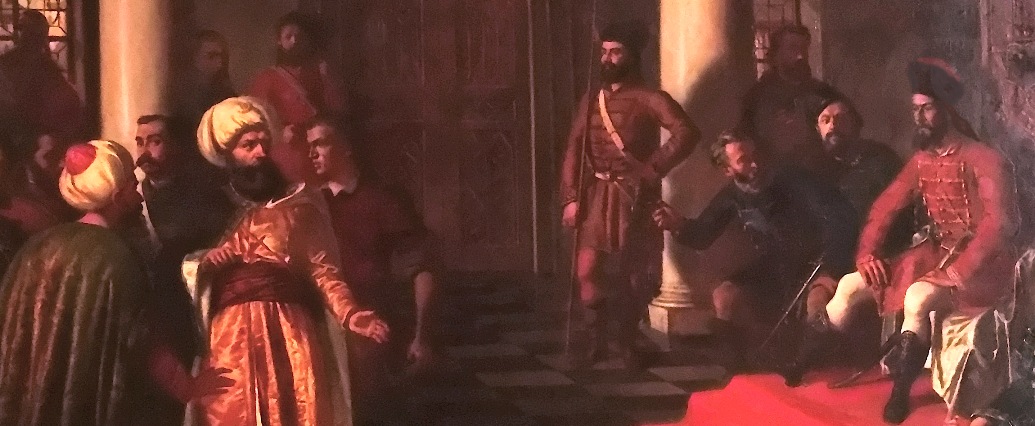
Vlad Dracula receives the Sultan's Envoys. They are
put to death. (by Theodor Aman)
Dracula embraced the strategy
that the best defence is a good offense. In February, he attacked Ottoman
territory in Bulgaria, slaughtering tens of thousands by impalement. This
stick in the eye woke the Ottoman beast.
The sultan gathered his
Islamic army and marched against Dracula’s Wallachia. Sultan Mehmed
intended to place a new leader in Wallachia, Dracula’s own brother Radu
“the Beautiful”. Radu was in fact a boyhood friend and lover of the sultan.
He had converted to Islam and was greatly favoured by the sultan. Radu stood
beside Mehmed at the fall of the last Eastern bastion of Christianity:
Constantinople. Radu was a 23-year-old commander within the Islamic
Janissary cavalry when Mehmed’s vast army moved against his brother Dracula.
Vlad Dracula
responded. He could not defeat the sultan on an open battlefield so he
embraced guerilla warfare, complete with brief lightning attacks on Islamic
forces. Dracula burned his own villages and crops, diverted streams to
create swamps, poisoned wells and drinking holes, and removed livestock to
the mountains. When it arrived, the Turkish army had nothing to eat or
drink.
Even germ warfare was
not beneath Dracula. Ill subjects suffering from leprosy, tuberculosis or
the bubonic plague were sent to infect the invaders. Disease spread through
the ranks of the Sultan’s army. Still the Ottomans advanced. Dracula had
to switch tactics and devised a fatal strike to the heart of his foe.
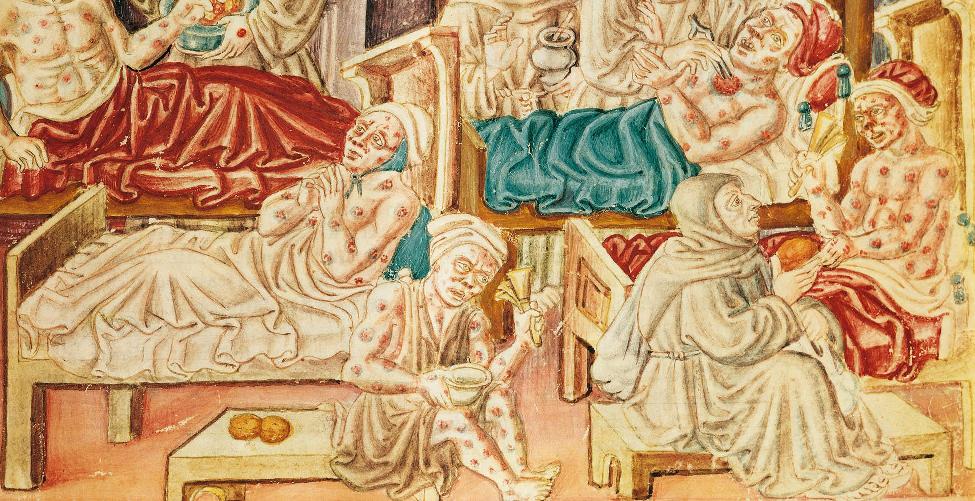
Plague victims in the 15th Century. One of
Dracula's weapons.
On June 17, 1492 the Sultan and his army of
100,000 troops had settled into their encampment on the road to Dracula’s
capital of Targoviste. Unbeknownst to them, Dracula disguised as a Turk
easily circulated through the tented city. Fluent in the Turkish language
from his time as a hostage, Vlad Dracula was able to locate the Sultan’s
heavily guarded tent. His reconnaissance completed, Dracula withdrew.
The cover of darkness
was needed. As soon as night fell, a glow appeared on the horizon. It grew
larger and moved closer to the Sultan’s camp.
Torches in hand, Dracula and
thousands of horsemen stormed into the encampment with the sole purpose of
killing the Sultan Mehmed. The Battle with torches was a scene of chaos and
carnage. Turks, horses, and camels were cut down. In the confusion, Dracula
entered the wrong tent, allowing his intended victim to escape. His plan
thwarted, Dracula disappeared back into the darkness.
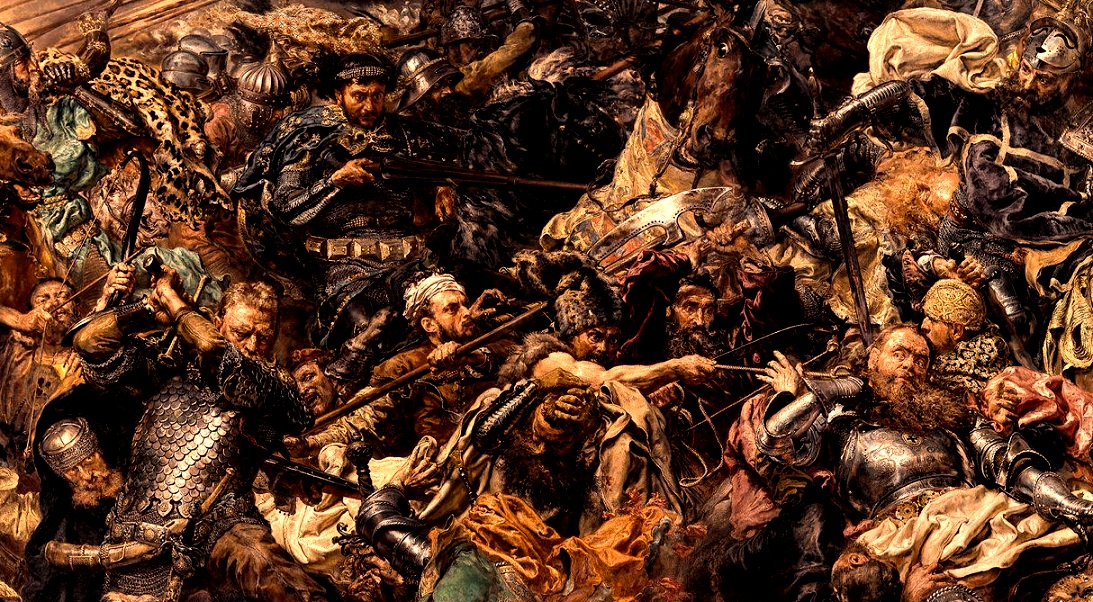
Chaos of Battle. Dracula's cavalry sounded horns to add
to the confusion.
The following day, the
Ottoman army marched on Dracula’s capital. A gruesome sight welcomed them.
It was a ghost city, populated only by the corpses of 20,000 Muslims,
impaled on stakes. On the tallest stake stood the limp figure of Hamza
Pasha, one of the Sultan’s governors. Dracula had fled Wallachia and taken
refuge in Transylvania to continue his guerilla war against Islam.
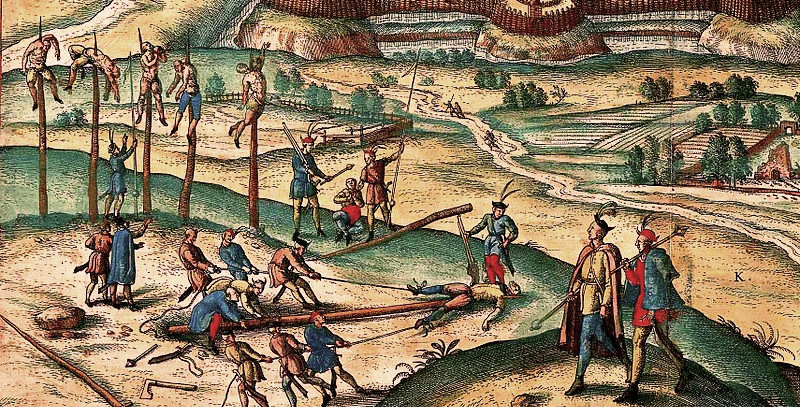
Impaling of Muslims by Dracula
How could Islamic
forces defeat a shadow? Faced with the choice between hunger and ongoing
night-time incursions by Dracula, or retreat from the cursed lands of
Wallachia, Sultan Mehmed chose the latter. Leaving a small force, and
enslaving all the Wallachians they could find, the Ottoman army withdrew.
Dracula had won, but
the cost was overwhelming. Vlad was a refugee with only a small band of
fighters. His nation was in ruins. He could only watch as his brother Radu
grew in popularity with Wallachians in opposition to Vlad the Impaler’s
tyrannical reign. But Dracula was not easily defeated. In an effort to take
back and rebuild Wallachia, he again turned to the King of Hungary for help.
Another betrayal awaited, and not to Vlad’s advantage. The Christian King
seized and imprisoned him.
Thirteen long years
later, the Ottomans inched closer to the Hungarian frontier and Dracula was
released to wage war again on Islam. He was reinstated as ruler of
Wallachia, but his reign was short lived. Dracula was purported to have been
killed during an Ottoman attack on Wallachia. Others suggest he was betrayed
and assassinated by Wallachian nobles. Eerily the date and
circumstances of Dracula’s demise remain a mystery.
The story of
Vlad Dracula inspired Bram Stoker to create the fictional vampire
Count Dracula in 1897. Elements of Vlad are sprinkled
throughout the pages of his horror novel: drinking of blood;
Transylvania terrorized; night attacks; and death by a wooden stake. However
the real Dracula was much more frightening.
 |
Author
Robert Henderson enjoys unearthing and
telling stories of military valour, heritage, and sacrifice
from across the globe. Lest we forget.
|
|